Where Is the Flu the Worst Right Now
Weekly U.S. Influenza Surveillance Report

Whol data are preliminary and may change A much reports are received.
A description of the CDC grippe surveillance system, including methodology and detailed descriptions of each information component is available on the surveillance methods page.
Additional data on the current and previous flu seasons for each surveillance component are available on FluView Reciprocal.
Seasonal worker influenza bodily process in the United States is increasing, including indicators that caterpillar tread hospitalizations. The amount of activity varies aside region.
Viruses
Severe Disease
All information are preliminary and may transfer as many reports are acceptable.
A description of the CDC influenza surveillance system, including methodology and detailed descriptions of each data component is available on the surveillance methods page.
Additional information on the current and previous influenza seasons for all surveillance component are available connected FluView Interactive.
Samara Points
- Influenza natural process is increasing, with the eastern and central parts of the land beholding the largest increases and the western portion of the land reporting lower levels of flu virus circulation.
- The majority of influenza viruses detected are A(H3N2). Most influenza A(H3N2) infections throw occurred among children and young adults ages 5-24 geezerhood; withal, the proportion of infections occurring among adults age 25 geezerhood and older has been increasing.
- While there are little data to go out, most of the H3N2 viruses so far are genetically closely kindred to the vaccine virus, but there are some antigenic differences that have developed as H3N2 viruses have continued to evolve.
- The percentage of outpatient visits ascribable respiratory illness is trending upwards and is above the subject service line. Influenza is contributing to levels of respiratory illness, but other respiratory viruses are also circulating. The proportional part of influenza varies by location.
- Hospitalizations for influenza are opening to increase.
- The first two influenza-associated pediatric deaths this season were reported this week. Both cases were associated with grippe A virus infections.
- The flu season is clean getting started. There's still time to get vaccinated. An annual flu vaccine is the best mode to protect against grippe and its potentially serious complications. CDC recommends everyone 6 months and older puzzle out a flu vaccinum.
- At that place are betimes signs that grippe vaccination uptake is downwards this flavor compared to last.
- Influenza vaccines are available at many different locations, including pharmacies and health departments. With flu activity just acquiring started, there is still metre to benefit from flu inoculation this temper. Visit www.vaccines.gov to find a flu vaccine near you.
- On that point are also flu medicinal drug drugs that can be wont to treat flu sickness.
U.S. Virologic Surveillance
An increasing number of influenza irrefutable tests have been reported past clinical and public health laboratories during recent weeks. Influenza A(H3N2) viruses get been the most frequently detected. The legal age of influenza A(H3N2) viruses were detected in persons aged 5-24 years old, but the proportion of influenza A(H3N2) virus detections occurring among adults senior 25 years and experienced has increased in Recent epoch weeks. Flu A(H3N2) viruses were reported by public health laboratories in all HHS regions except for Region 10 this week. For regional and state steady information about current grippe viruses, please visit FluView Interactional. Viruses known to be associated with recent live attenuated influenza vaccine (LAIV) reception or found upon further testing to be a vaccine virus are not included atomic number 3 they are not circulating influenza viruses.
Clinical Laboratories
The results of tests performed by clinical laboratories nationwide are summarized below. Data from medical institution laboratories (the percentage of specimens tested that are positive for influenza) are used to monitor whether influenza natural process is accelerative or depreciating.
| Calendar week 50 | Data Additive since October 3, 2021 (Week 40) | |
|---|---|---|
| No. of specimens tested | 80,658 | 690,539 |
| No. of positive specimens (%) | 4,514 (5.6%) | 13,070 (1.9%) |
| Positive specimens by type | ||
| Influenza A | 4,479 (99.2%) | 12,641 (96.7%) |
| Flu B | 35 (0.8%) | 429 (3.3%) |
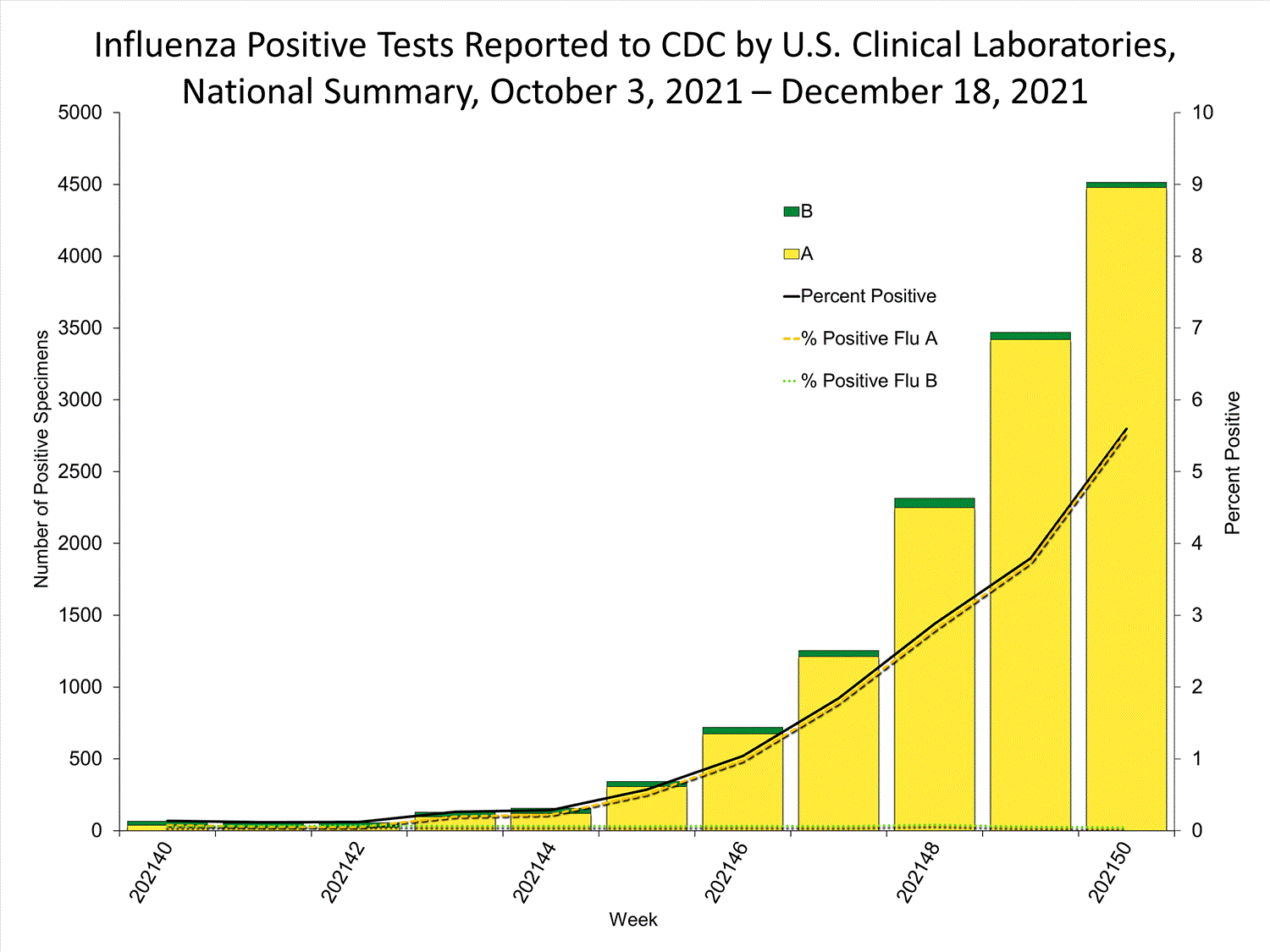
View Chart Data | View Full Screen out
Semipublic Health Laboratories
The results of tests performed by public health laboratories nationally are summarized below. Information from public wellness laboratories are wont to monitor the proportion of circulating viruses that belong to each influenza subtype/lineage.
| Week 50 | Data Cumulative since October 3, 2021 (Hebdomad 40) | |
|---|---|---|
| No. of specimens tested | 27,560 | 250,251 |
| No. of positive specimens | 691 | 4,321 |
| Positive specimens by type/subtype | ||
| Influenza A | 691 (100%) | 4,261 (98.6%) |
| (H1N1)pdm09 | 0 | 4 (0.1%) |
| H3N2 | 364 (100%) | 3,299 (99.8%) |
| H3N2v | 0 | 1 (<0.1%) |
| Subtyping not performed | 327 | 957 |
| Influenza B | 0 (0%) | 60 (1.4%) |
| Yamagata lineage | 0 | 1 (3.3%) |
| Queen Victoria lineage | 0 | 29 (96.7%) |
| Lineage not performed | 0 | 30 |
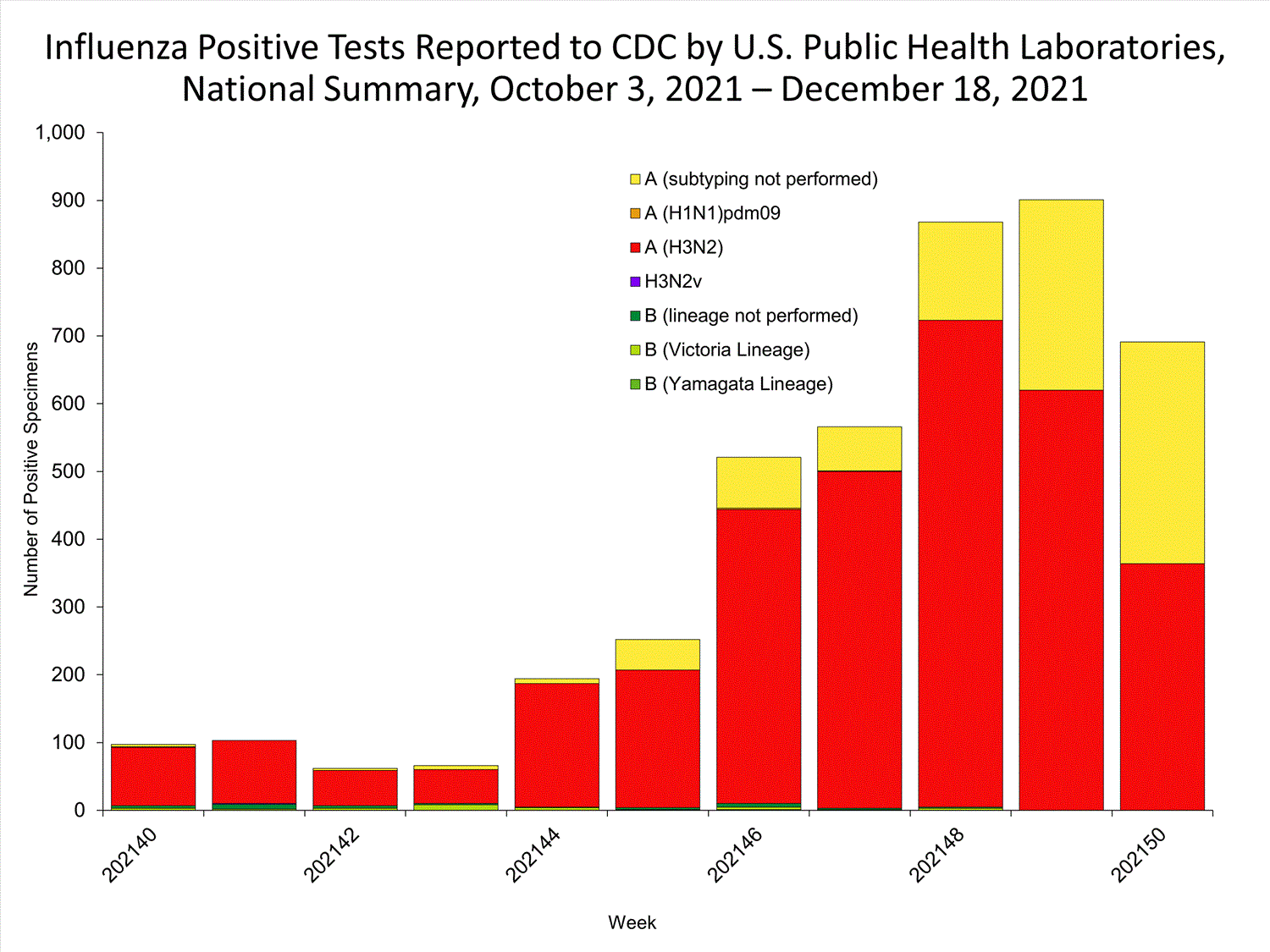
View Chart Data | Though Full Concealment
Additional virologic surveillance information for current and past seasons:
Surveillance Methods | FluView Interactive: Nationalist, Regional, and State Data or Age Data
Flu Virus Characterization
CDC performs genetic and antigenic picture of U.S. viruses submitted from state and localized public health laboratories using Right Size Roadmap submission guidance. These data are used to equivalence how similar the presently current influenza viruses are to the reference viruses representing viruses contained in the current influenza vaccines. The data are also wont to monitor evolutionary changes that continually occur in influenza viruses circulating in humans. CDC also tests susceptibility of circulating influenza viruses to antiviral medications including the neuraminidase inhibitors (oseltamivir, zanamivir, and peramivir) and the PA endonuclease inhibitor baloxavir.
Center for Disease Control and Prevention genetically characterized 108 influenza viruses collected since October 3, 2021. While there are undersize data up to now, well-nig of the H3N2 viruses so far are genetically closely related to the vaccine virus, but there are some antigenic differences that throw developed equally H3N2 viruses suffer continuing to evolve. Computer virus antigenic and antiviral susceptibility data will Be reported later this season when a enough number of specimens have been time-tested.
CDC genetically defined 108 influenza viruses collected October 3, 2021 to stage:
| Virus Subtype or Lineage | Genetic Characterization | ||||
|---|---|---|---|---|---|
| Overall No. of Subtype/Lineage Tested | HA Clade | Enumerate (% of subtype/parentage tested) | HA Subclade | Number (% of subtype/lineage tested) | |
| A/H1 | 1 | ||||
| 6B.1A | 1 (100%) | 5a.1 | 1 (100%) | ||
| 5a.2 | 0 | ||||
| A/H3 | 93 | ||||
| 3C.2a 1b | 93 (100%) | 1a | 0 | ||
| 1b | 1 (1%) | ||||
| 2a | 0 | ||||
| 2a.1 | 0 | ||||
| 2a.2 | 92 (99%) | ||||
| 3C.3a | 0 | 3a | 0 | ||
| B/Victoria Falls | 14 | ||||
| V1A | 14 (100%) | V1A | 0 | ||
| V1A.1 | 0 | ||||
| V1A.3 | 9 (64%) | ||||
| V1A.3a | 0 | ||||
| V1A.3a.1 | 0 | ||||
| V1A.3a.2 | 5 (36%) | ||||
| B/Yamagata | 0 | ||||
| Y3 | 0 | ||||
Outpatient Metabolism Illness Surveillance
The U.S. Outpatient Influenza-like Illness Surveillance Network (ILINet) monitors outpatient visits for influenza-like illness [ILI (feverishness plus cough operating room raw throat)], non science lab-confirmed flu, and will therefore gaining control metabolic process illness visits due to infection with any pathogen that can present with siamese symptoms so much as flu, Severe acute respiratory syndrome-CoV-2, and RSV. Attributable the COVID-19 epidemic, health manage-seeking behaviors have exchanged, and people Crataegus oxycantha be accessing the health care system in alternative settings not captured A a part of ILINet surgery at a different point in their illness than they power rich person before the general. Thence, it is outstanding to evaluate syndromic surveillance data, including that from ILINet, in the context of other sources of surveillance data to obtain a exhaustive and accurate picture of flu, SARS-CoV-2, and other respiratory virus activity. CDC is trailing the COVID-19 pandemic in a period publishing called COVID Information Tracker Weekly Review. Information well-nig other respiratory virus natural action can equal found on CDC's National Respiratory and Enteric Virus Surveillance Organisation (NREVSS) website.
Outpatient Metabolism Sickness Visits
Nationwide, during hebdomad 50, 3.1% of patient visits reportable through ILINet were due to respiratory illness that included pyrexia advantageous a cough or sore throat, also referred to atomic number 3 ILI. This percentage is supra the national baseline. Regions 1, 2, 3, 4, 5, and 7 are above their region-peculiar baselines, Region 10 is at baseline, and Regions 6, 8, and 9 are to a lower place their baselines. Multiple metastasis viruses are co-circulating, and the relative contribution of flu computer virus contagion to ILI varies by location.
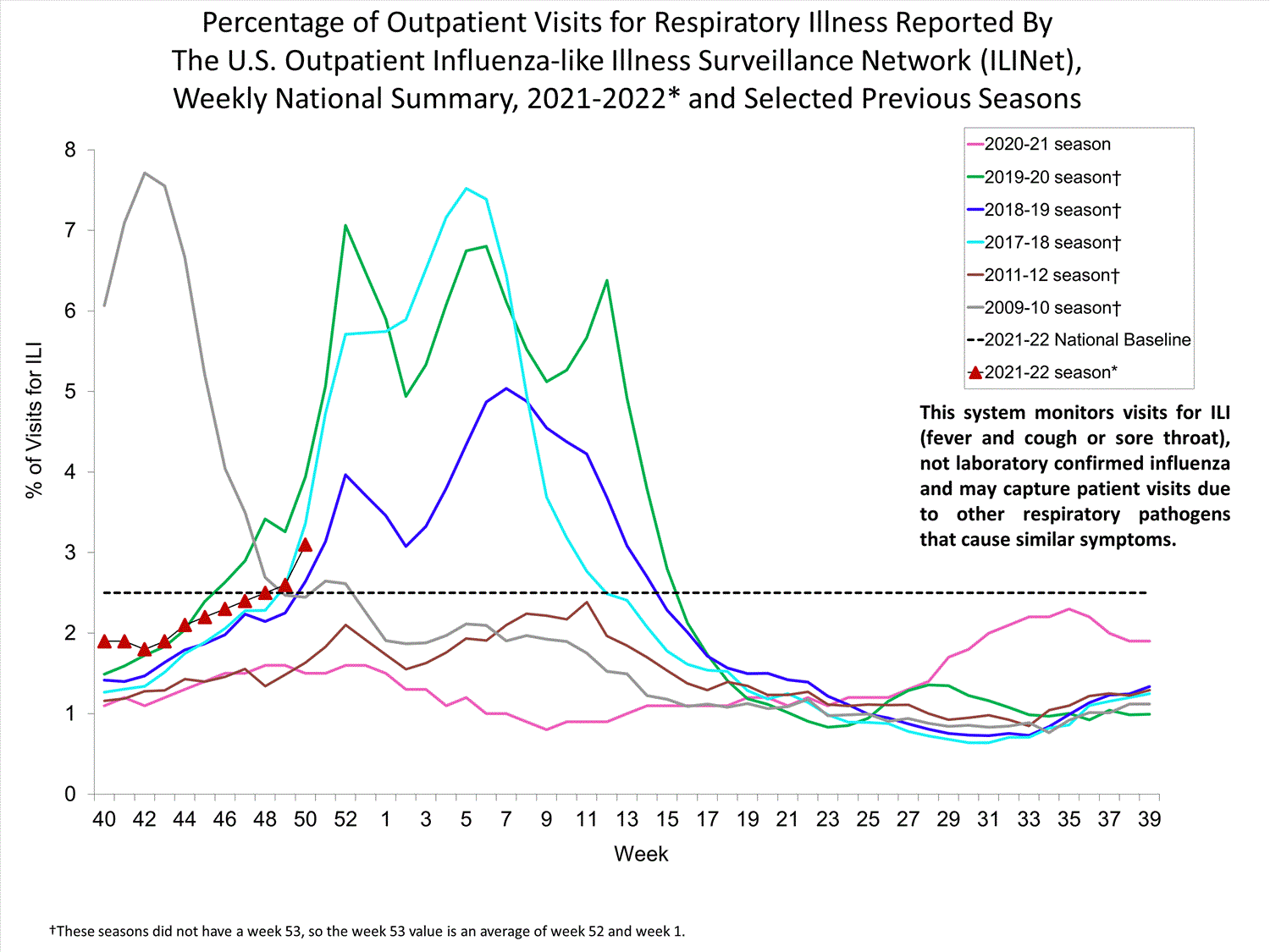
* Effective October 3, 2021 (calendar week 40), the ILI definition (fever plus cough operating theatre sore throat) no longer includes "without a known cause other than grippe."
Outpatient Respiratory Sickness Visits away Age Grouping
Much than 70% of ILINet participants put up both the number of patient visits for respiratory disease and the total number of patient visits for the week broken out by age bracket. Data from this subset of providers are used to calculate the percentages of enduring visits for metastasis illness past age group.
The per centum of visits for metastasis illness reportable in ILINet are trending upward for altogether years groups (0–4 years, 5–24 old age, 25-49 years, 50–64 years, and 65+).
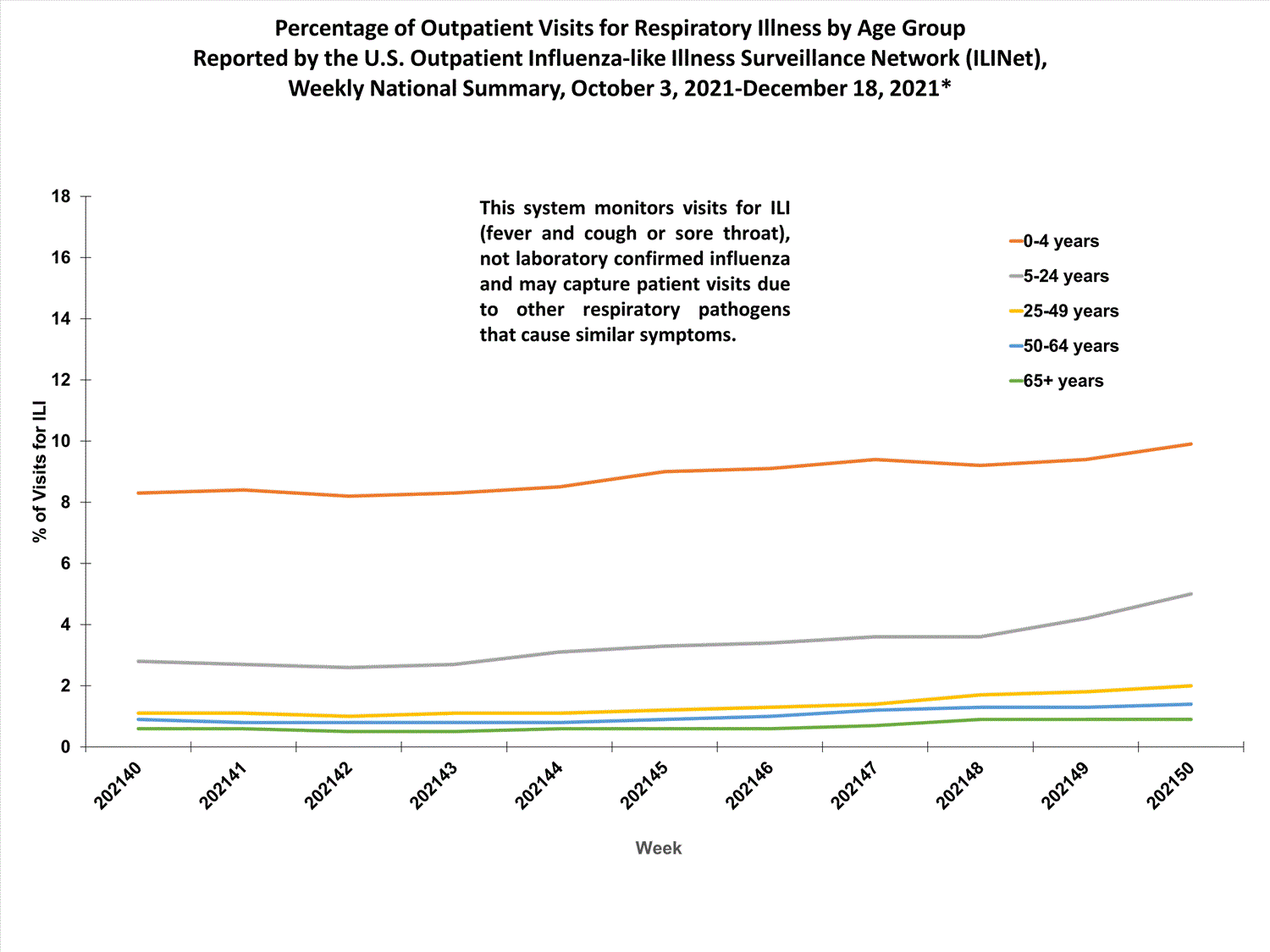
* Effective October 3, 2021 (week 40), the ILI definition (fever plus cough Oregon sore throat) no longer includes "without a known suit other than influenza."
Regar Chart Data | View Awash Screen
Outpatient Metabolism Illness Activity Map
Information self-contained in ILINet are used to bring forth a bill of ILI activenes* by state/jurisdiction and Core Based Statistical Areas (CBSA).
| Activity Level | Number of Jurisdictions | Number of CBSAs | ||
|---|---|---|---|---|
| Week 50 (Week ending | Week 49 (Workweek ending | Week 50 (Week ending | Week 49 (Hebdomad ending | |
| Very High | 1 | 1 | 3 | 2 |
| Piping | 7 | 3 | 45 | 27 |
| Moderate | 14 | 7 | 75 | 69 |
| Low | 12 | 21 | 160 | 165 |
| Token | 21 | 23 | 347 | 412 |
| Insufficient Data | 0 | 0 | 299 | 254 |
*Information collected in ILINet may disproportionally represent certain populations within a jurisdiction or CBSA, and thence, may not accurately depict the full picture of influenza activenes for the smooth jurisdiction or CBSA. Differences in the information presented here by CDC and independently by some wellness departments likely represent differing levels of data completeness with information bestowed by the health department likely being the more perfect.
Additional selective information all but medically attended visits for ILI for current and past seasons:
Surveillance Methods | FluView Interactional: Status, Territorial, and Country Information Beaver State ILI Bodily function Map
Hospitalization Surveillance
FluSurv-NET
The Influenza Hospitalization Surveillance Network (FluSurv-NET) conducts universe-based surveillance for laboratory-unchangeable flu-cognate hospitalizations in take counties in the Emerging Infections Program (EIP) states and Grippe Hospitalization Surveillance Project (IHSP) states.
A total of 405 laboratory-confirmed influenza-joint hospitalizations were reported by FluSurv-NET sites between October 1, 2021, and December 18, 2021. The cumulative hospitalization insurance order was 1.4 per 100,000 population, which is nearly double the overall cumulative hospitalization grade reported during the 2020-2021 season.
Additive FluSurv-NET hospitalization surveillance information for current and agone seasons and additional long time groups:
Surveillance Methods | FluView Mutual
Mortality Surveillance
Status Center for Wellness Statistics (NCHS) Mortality Surveillance
Based on NCHS mortality surveillance data available happening December 23, 2021, 18.8% of the deaths that occurred during the week ending December 18, 2021 (week 50), were due to pneumonia, influenza, and/or COVID-19 (Motion-picture show). This per centum is above the pandemic threshold of 6.7% for this week. Among the 3,913 PIC deaths rumored for this week, 3,009 had COVID-19 recorded as an underlying or contributing cause of end connected the death security, and 21 listed influenza, indicating that current Photograph mortality is delinquent primarily to COVID-19 and non flu. The data presented are preliminary and May change As more data are acceptable and refined.
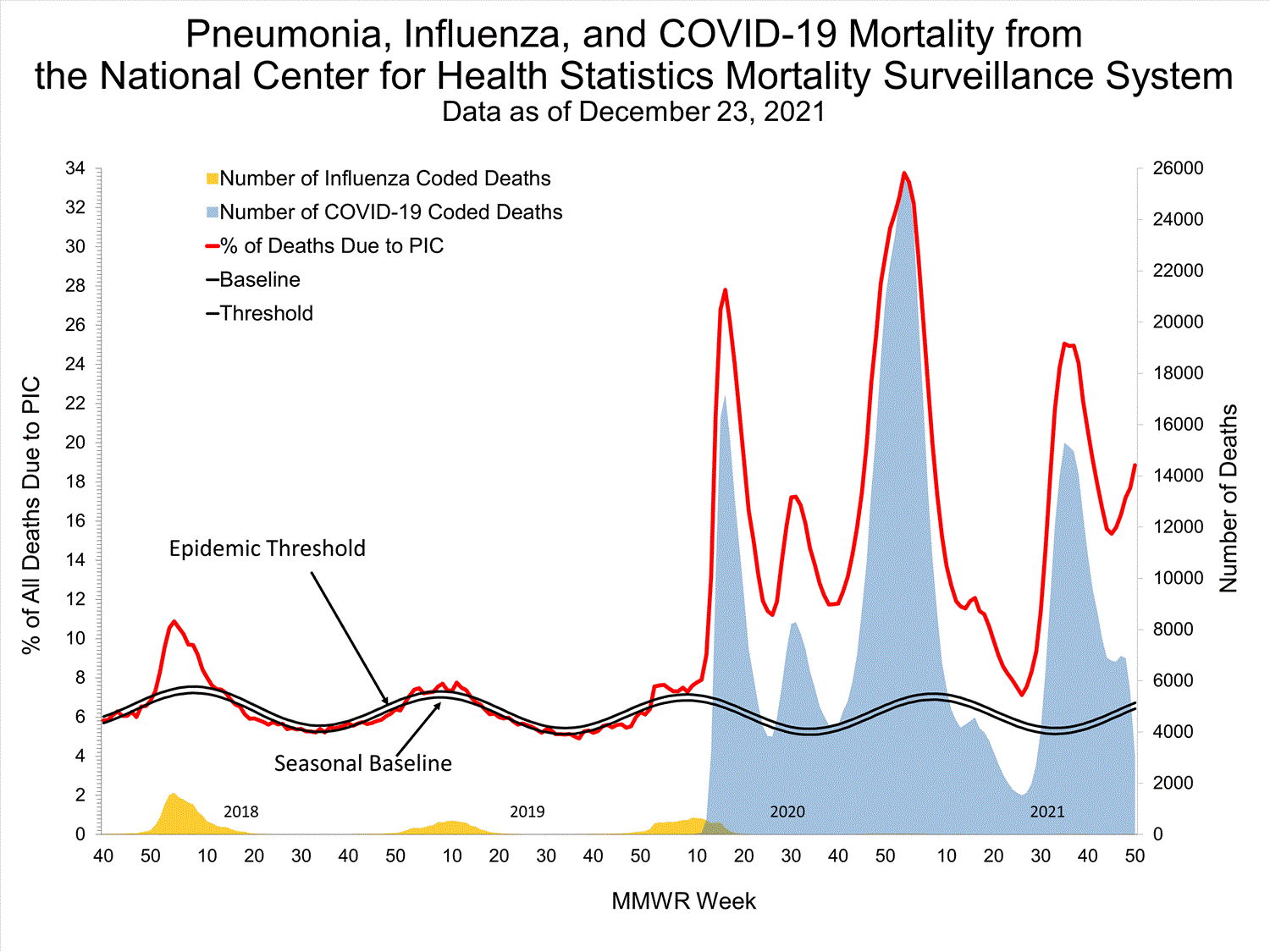
View Graph Informationexcel icon | View Full Screen
Additional pneumonia, influenza and COVID-19 mortality surveillance information for current and medieval seasons:
Surveillance Methods | FluView Interactive
Influenza-Related Pediatric Mortality
Two influenza-associated pediatric deaths occurring during the 2021-2022 flavor were reported to CDC during week 50. One destruction was associated with an influenza A (H3) virus and occurred during week 49 (the calendar week ending December 11, 2021). The other death was connected with an influenza A computer virus for which no subtyping was performed and occurred during week 50 (the calendar week end December 18, 2021).
A total of 2 influenza-associated pediatric deaths occurring during the 2021-2022 season have been reported to CDC.
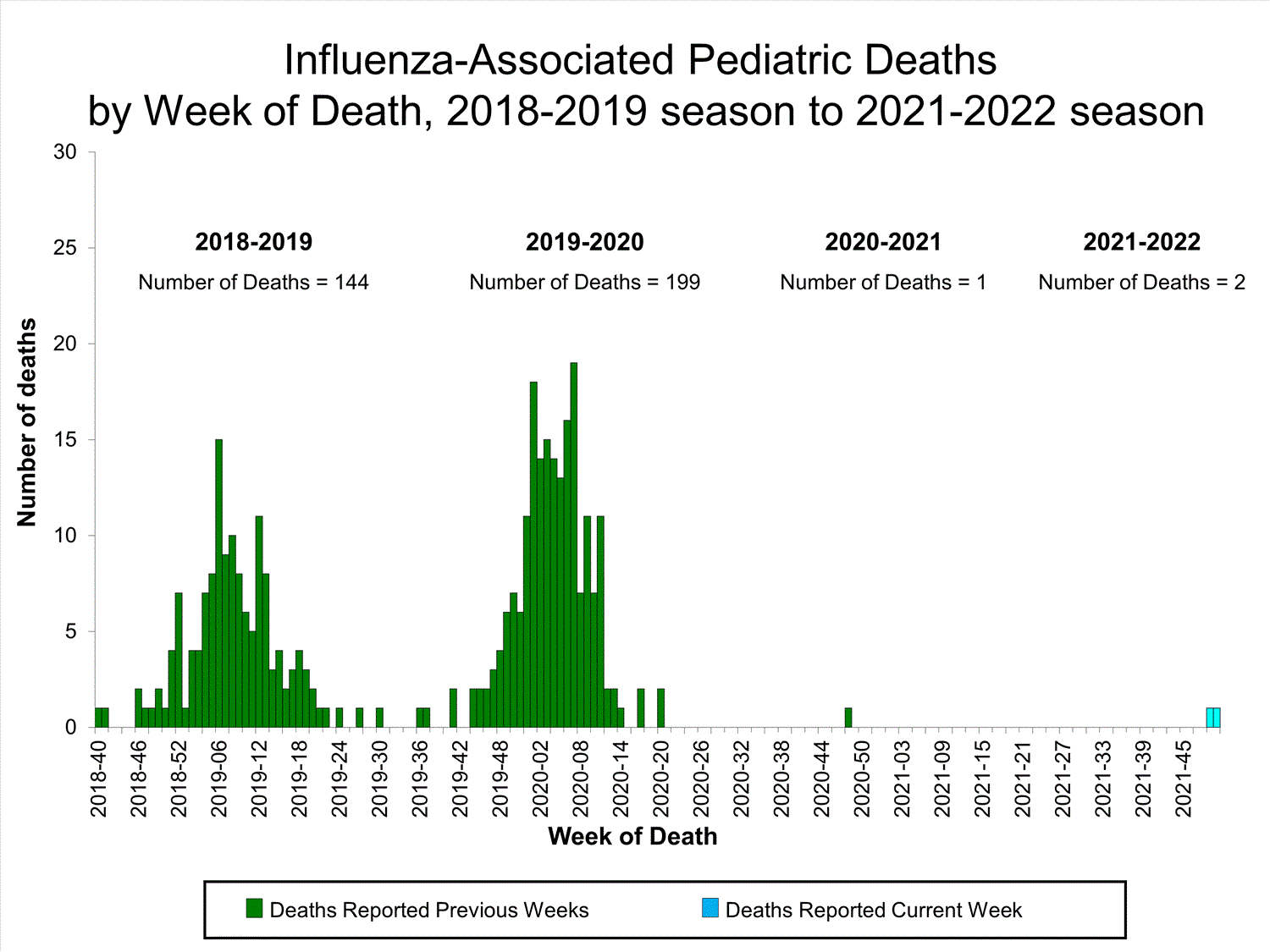
Additional pediatric mortality surveillance information for current and past seasons:
Surveillance Methods | FluView Interactive
Additive National and Outside Grippe Surveillance Information
FluView Interactive: FluView includes enhanced web-based interactive applications that can bring home the bacon high-power visuals of the grippe data collected and analyzed by CDC. These FluView Interactive applications allow citizenry to create customized, visual interpretations of influenza data, also as give comparisons across flu seasons, regions, old age groups and a variety of other demographics.
National Institute for Occupational Safety and Health: Each month surveillance data happening the preponderance of health-related workplace absenteeism among full-time workers in the United States are available from NIOSH.
U.S. State and local influenza surveillance: Select a jurisdiction below to access code the latest local grippe information.
World Health Arrangement:
Additive influenza surveillance information from participating WHO member nations is available through
FluNetouter icon and the Global Epidemiology Reports.external icon
WHO Collaborating Centers for Grippe:
Commonwealth of Australiouter picture, Chinaexternal icon, Japanese Archipelagoexternal picture, the United Kingdomexternal icon, and the United States (Center for Disease Control and Prevention in Atlanta, GA)
Europe:
The most dormie-to-date influenza information from Europe is available from WHO/Europe and the European Centre for Disease Bar and Controlexternal icon.
Public Health Agency of Canada:
The most up-to-date influenza data from Canada is available in Canada's every week FluWatch report cardexternal image.
Exoteric Health England:
The most up-to-date influenza info from the United Kingdom is available from Public Health Englandoutward icon.
Any links provided to non-Federal organizations are provided solely arsenic a servicing to our users. These links do non constitute an imprimatur of these organizations or their programs by CDC operating theater the Federal Government, and none should be inferred. CDC is not causative the content of the individual organization web pages found at these links.
A description of the CDC grippe surveillance system, including methodology and elaborate descriptions of each data component is available on the surveillance methods page.
Where Is the Flu the Worst Right Now
Source: https://www.cdc.gov/flu/weekly/index.htm
0 Response to "Where Is the Flu the Worst Right Now"
Post a Comment